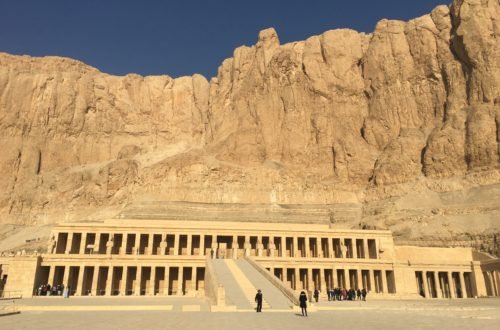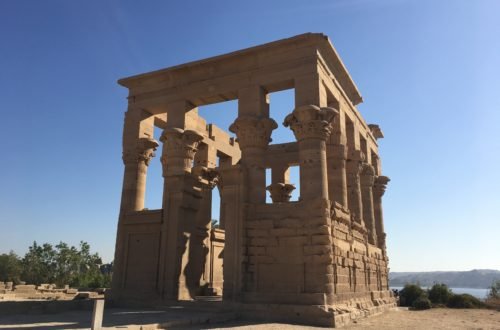
Inside Luxor temple and the tombs in the Valley of Kings
Luxor and Karnak are among the biggest temples of Ancient Egypt. Both temples are located in Thebes, the former capital of the empire, now called Luxor. The scale of the constructions here is incredible. Not only did the Egyptians build these wonders out of the ground. They also constructed inside the surrounding mountains the greatest royal necropolis. At least 150 kings and queens are buried in the region.
Empires rise and fall. So did the empire of pharaohs. After 30 centuries of domination, the rule of pharaohs declined. A new power emerged with the development of the Roman empire and then the birth of Islam. Yet, Ancient Egypt remains one of the great civilizations of the world and humankind history. Nothing was too beautiful or too extravagant for the gods, nor for the kings and queens of Ancient Egypt.
/ Sunset at Luxor temple
/ Love ritual of Amon and Mut
/ Luxor temple by night
/ Alone in the Valley of Kings at 6AM
/ Underground splendours
/ Related: Egypt, Luxor, Valley of Kings, Pharaohs, Luxor temple, Tombs
/ Inspiration:
Ramses – The Son of Light (by Christian Jacq, 1995)
The Mummy (film by Stephen Sommers, 1999)
Rome (series by Bruno Heller, 2005-2007)
Sunset at Luxor temple
It is standing here, right on the Nile river bank, since 1.400 BC. For 35 centuries, Luxor temple has seen countless revolutions of the sun and the moon. It resisted the Nile flooding, the invasions and the assaults of time. Sunset is upon Luxor when I reach the East bank by ferry. It is a day like any other. But it does feel special to be at the temple at this time of the day.
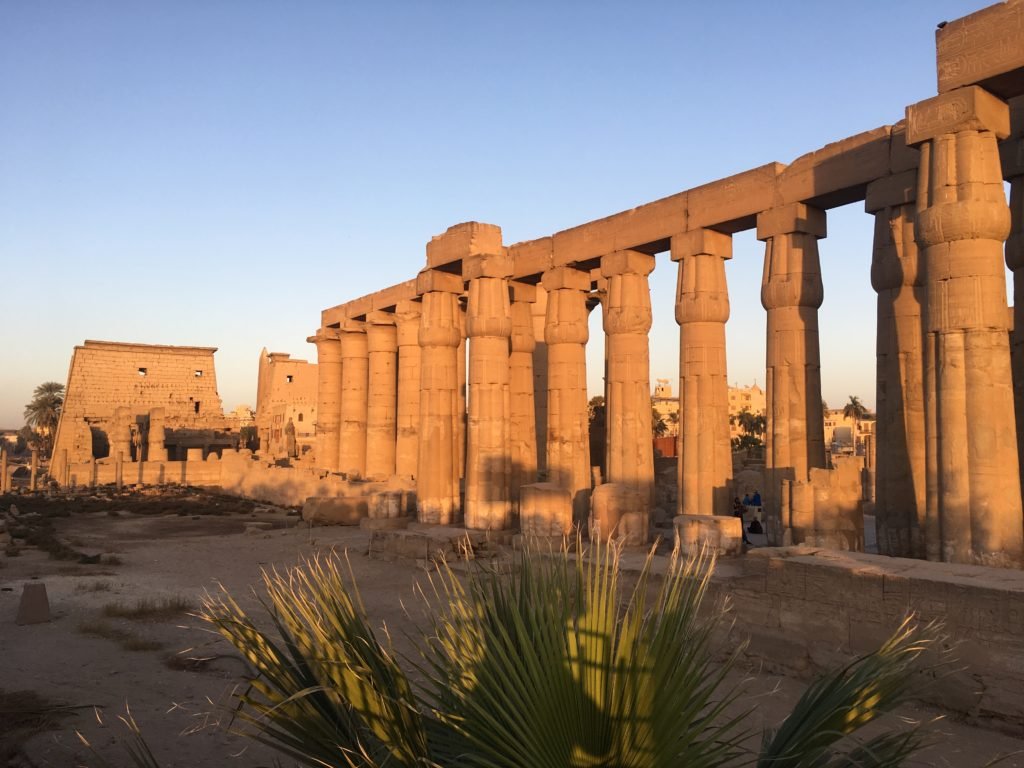
From outside, you can tell the temple is big. It takes a few minutes to reach the other side and the ticket office. The columns are tall and elegant. As the sun continues its course down, the whole temple becomes gold. Each stone reflects the golden light of the dying sun. The first stars points in the darkening sky.
I penetrate inside the complex. At my back, the grandiose Sphinx alley which leads to Karnak temple, a few kilometres away. In front of me, the temple entrance with its single obelisk. Its twin stands on the Concorde square in Paris. The hieroglyphs carving is amazingly sharp and unaltered for such old stones.
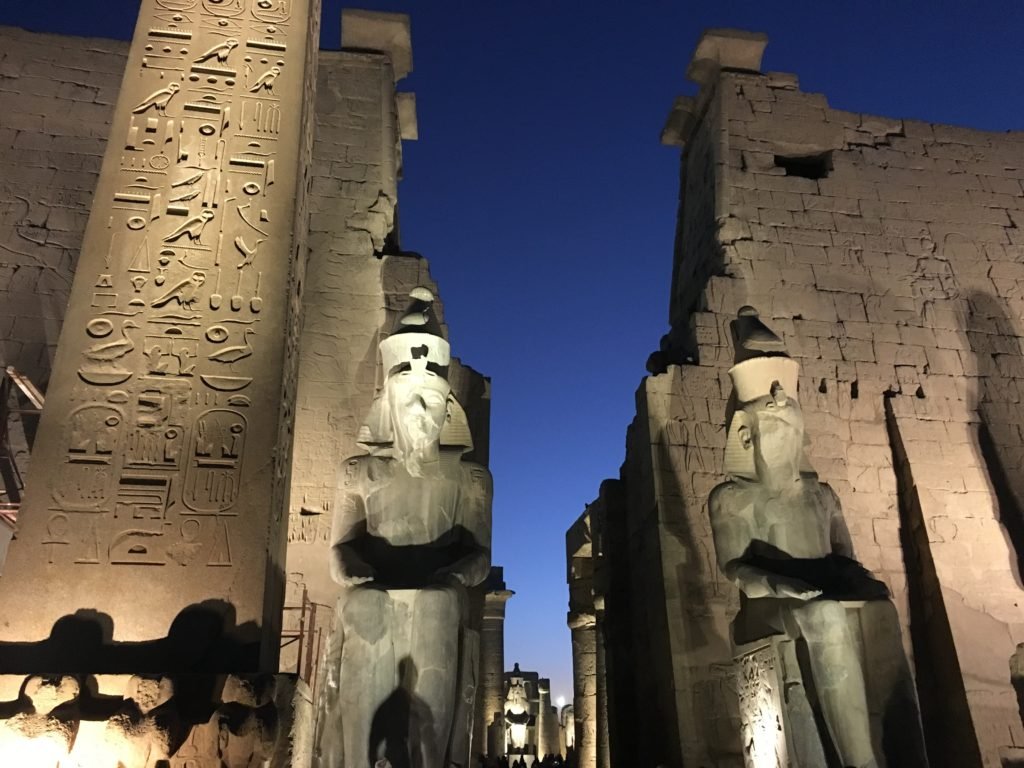
Right and left, monumental statues of Ramses II smile at the visitors. They look impressive of course. But more than that, they look both kind hearted and intimidating. I am rather tall for a woman but I feel very small when I enter the temple and look up towards the statues. These men were kings and made sure to be remembered as such across ages. Well, it is a success!
Walking towards sunset between the columns, I reach the last courtyard and the former shrine hosting the god Amon statue. The roof is missing and the last sun rays of the day bring their fading light on delicate frescos. Faces appear on one of the corners. This place was converted into a church by early Christians before the sands of the desert covered it all again and archaeologists found interest in the temple again, centuries later.
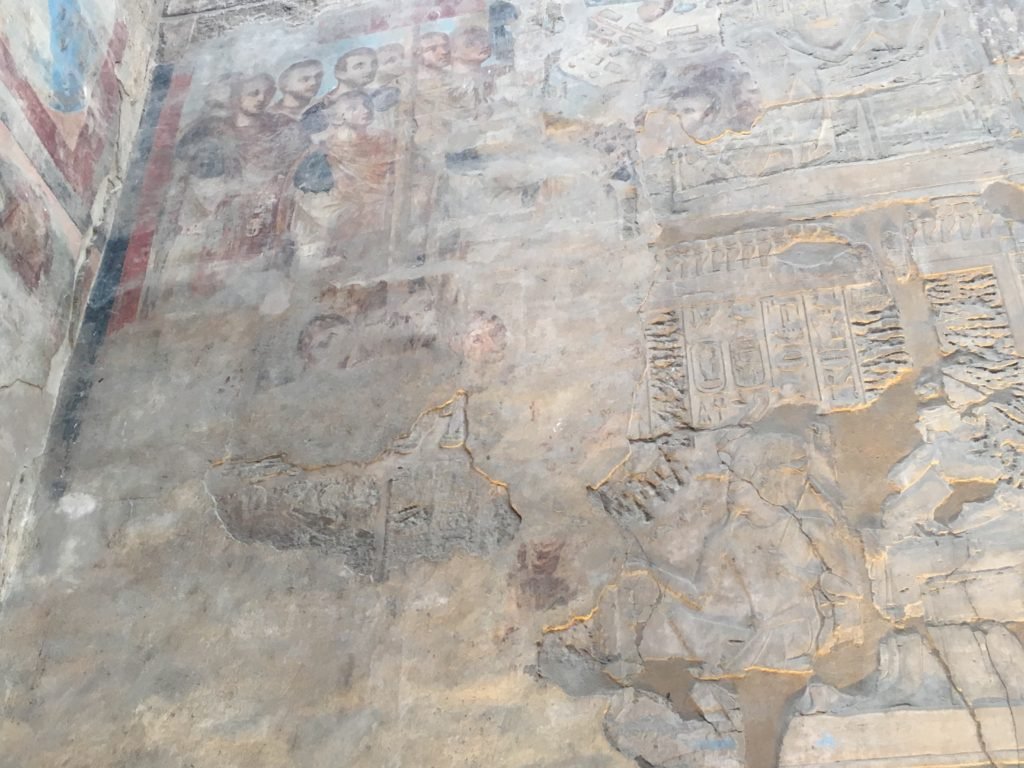
Love ritual of Amon and Mut
What about the temple’s purpose in Ancient Egypt at the zenith of Pharaohs ruling? Luxor temple is entirely dedicated to the god Amon. It was the final destination of the Opet festival which took place during the annual Nile flooding. The festival was a celebration of fertility and renewal of the king power. Distant from about 2.5 kilometres, Luxor and Karnak temples are located along the Nile on the East bank. An alley of human headed sphinxes connect the two temples. It seems, like the Chinese terracotta army in Xian, that each face is unique. These sphinxes are not clones but individuals.

Today, only the alley’s portion close to Luxor’s temple is still recognizable and renovated. Modern asphalted roads cross the alley on several points and most of the alley is in a dilapidated state. The axe is clearly visible but the pavement is in ruin and almost all the sphinx statues are missing.
In ancient times, a procession carrying a representation of Amon would leave every year from Karnak temple. Dancers, offerings and musicians accompanied the divinity. The procession would stop on its way to Luxor’s temple for prayers and offerings. Until the divine boat reaches Luxor’s deepest vault. The love ritual then takes place during which Amon and Mut unit again. Fertility would be renewed for the upcoming year, until next year’s flooding and Opet festival.

The shrine is entirely decorated with carvings and paintings from top to bottom. During 24 days, the statues of Amon and Mut remain inside the shrine for the purpose of the fertility ritual. After which, Amon makes the journey home to Karnak temple. It happened sometimes that the procession took the Nile instead of the road. This is the story I have been told during my visit of Luxor and the one you often find in guidebooks. It is true however that very few information came to us regarding this Opet festival. Once again, Egypt keeps some of its secrets.
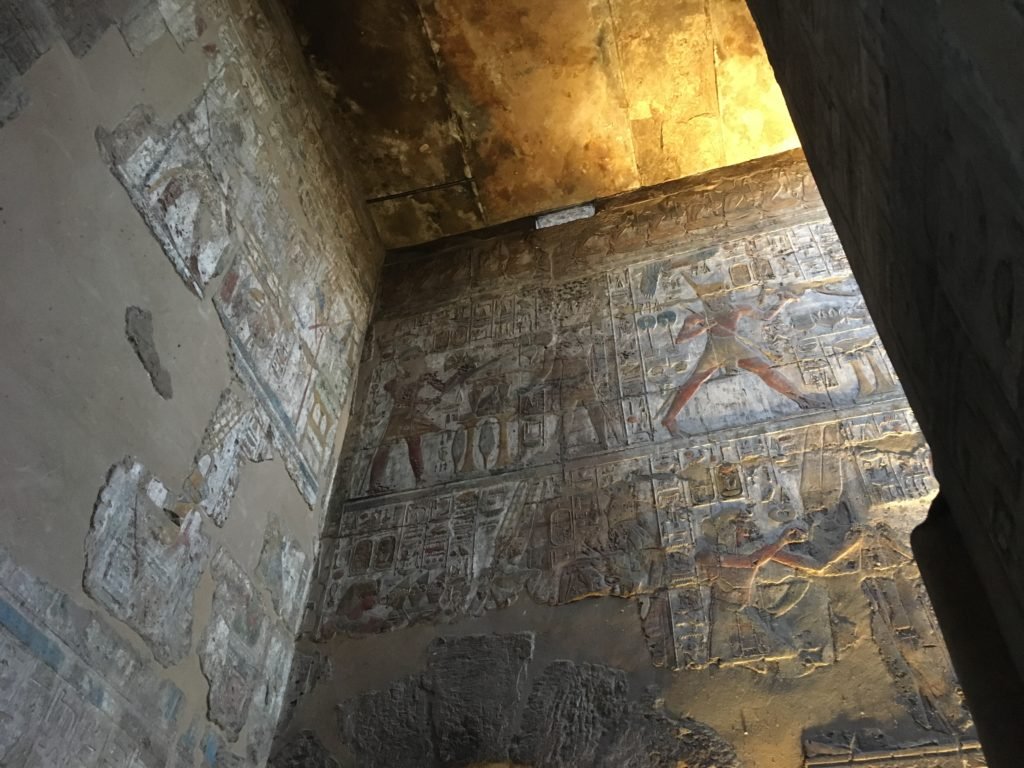
Luxor temple by night
When the sky is all but darkness, Luxor temple changes completely. It is like starting anew the visit. Colours, dimensions, perspectives, everything looks different under the white lights of stars and projectors. A few moments earlier, the temple was crowded with tourists on every corner. Now they are gone for dinner. Soon the doors will close until next morning. I still have some more time to explore. The highlight of this nocturnal visit is without doubt the 60 standing columns of the Amenophis III square. No words can describe it properly.
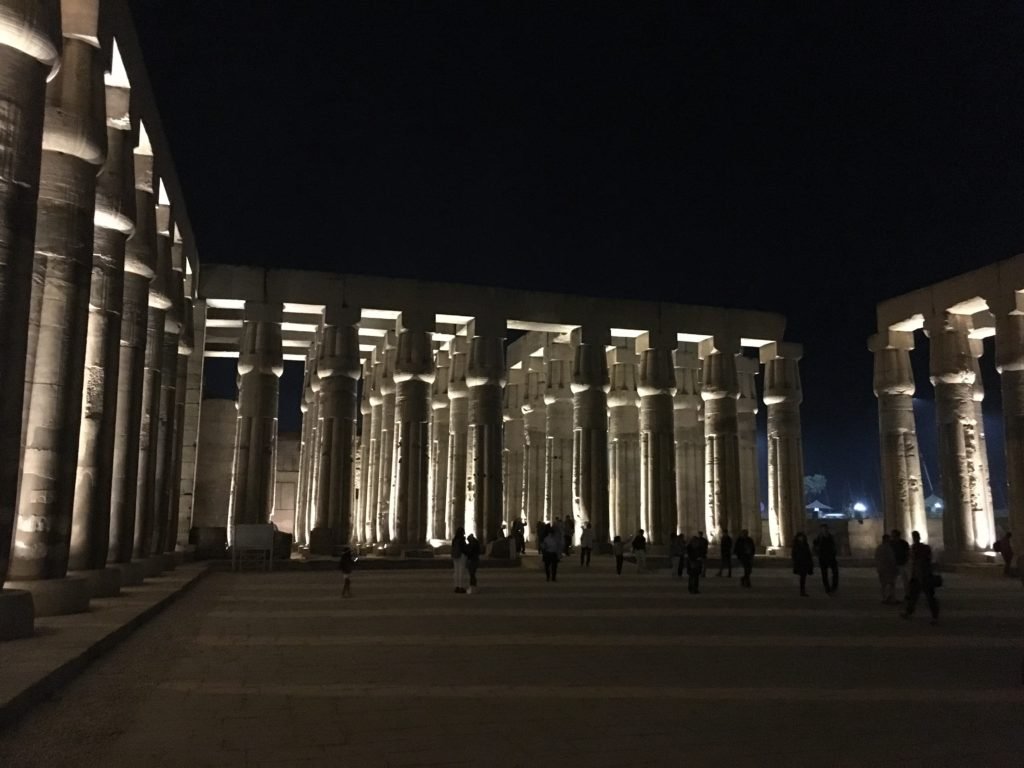
In the first courtyard, the Abu El-Hagag mosque stands on the left. It is odd to see a Muslim place of worship inside an antic temple dedicated to pagan gods. I learn the mosque construction dates back to the 11th century and it is still active today. As a matter of fact, I did hear the muezzin calling for the evening prayer from the minaret just before sunset.
Pharaoh Amenophis III (1390-1352 BC) started the construction of the temple. An interesting story about this pharaoh is the myth of his birth. His mother was a slave. Not very fitting for a pharaoh… So he created a new storyline in which he is the son of a woman and the god Amon. Much more fitting! The detailed story is depicted on the walls of the inner temple. Amenophis III is not the only one who used a divine parentage. Queen Hatchepsut had done the same less than a hundred years before him.
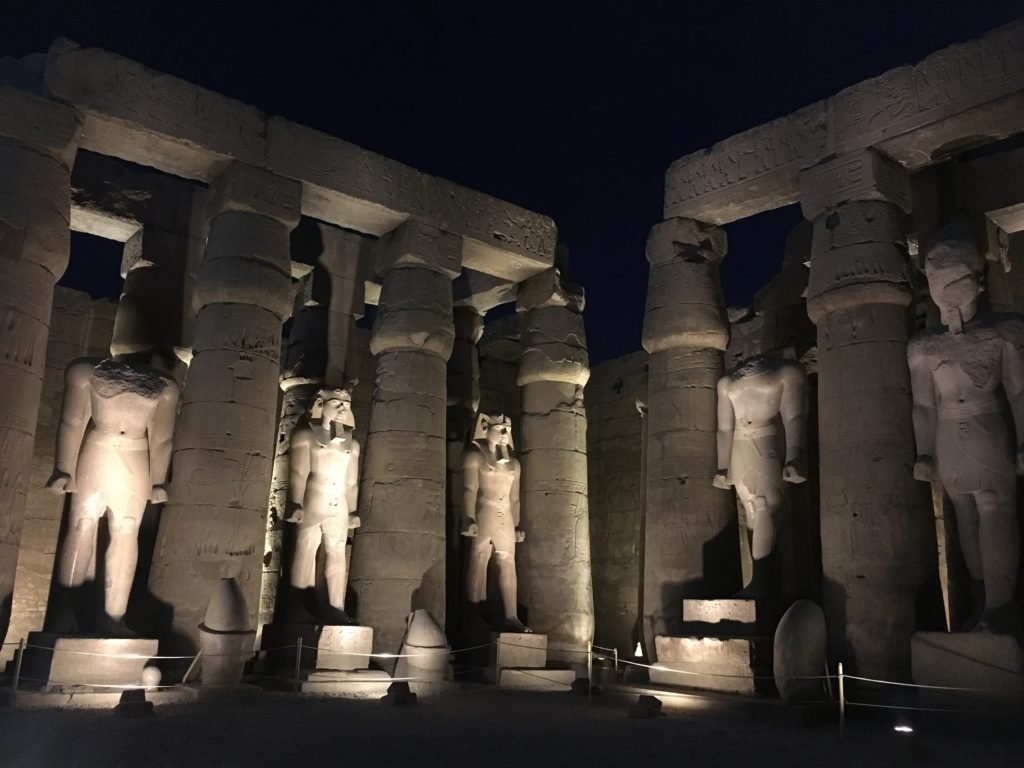
Ramesses II (1279-1213 BC) made significant further construction work after Amenophis III, adding the statues representing himself and the twin obelisks at the temple’s main entrance. And he also commissioned the commemoration on the wall celebrating his victory at the battle of Kadesh (1275 BC). So much for the greatness of Egypt rulers.
By the time the Romans had built their empire, Thebes was a ruin. Romans already came here for tourism. Under Arabs ruling, around the 7th century AD, the former capital city and its marvellous temples were forgotten by all. The city became Al-Uqsor “the palace fortress”. Sands buried the columns and inhabitants built their houses among the ruins. Archaeologists are still working on the site nowadays, here at the temple and also on the West bank in the Valley of Kings. That is where I am heading to in a few hours.
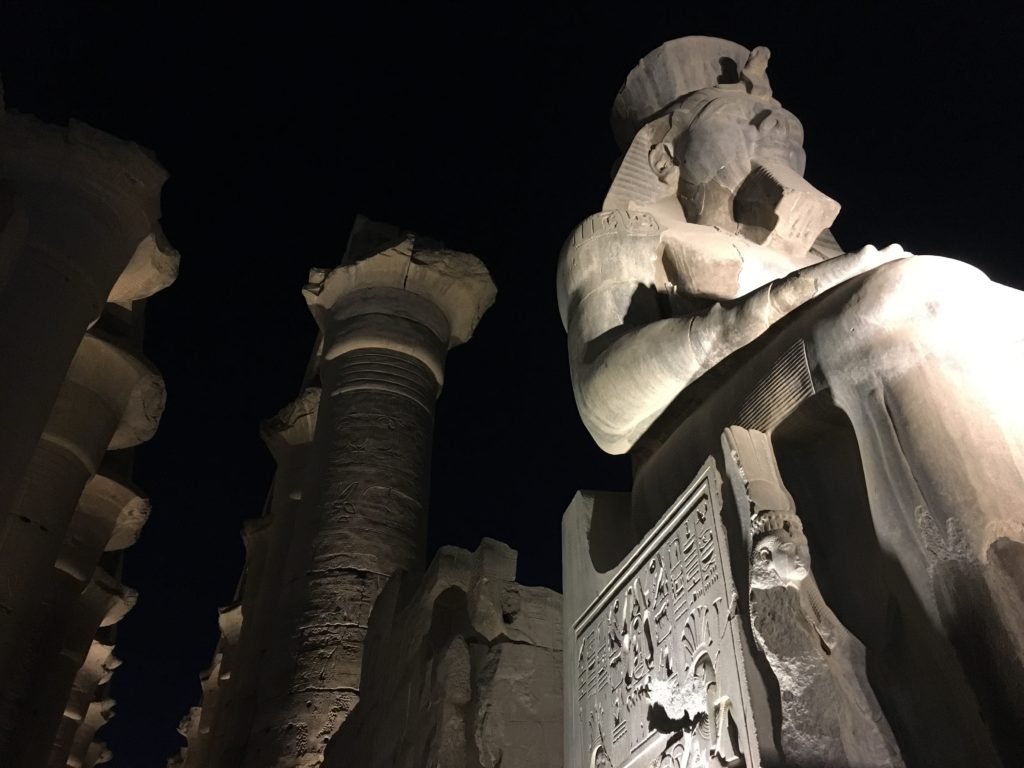
Alone in the Valley of Kings at 6AM
Nice dinner and a few hours sleep after my visit at Luxor’s temple, I’m off again. It is still dark and quiet outside when I join the taxi driver at 6AM. It takes about 10min ride under the fading stars to reach the surrounding mountains. We see no one. The vast parking lot for buses is completely empty. So is the tourist souk leading to the Valley of Kings entrance office.
The ticket officer is still sleepy and very surprised to see me asking for a ticket. I have the honour of getting the first ticket sold that day, hurra! Truth is, it is an amazing sensation to get the whole Valley of Kings and its tombs to yourself. From outside, only bare mountains and a black road in the middle. To the left and to the right, holes in the ground mark the entrance of the tombs.
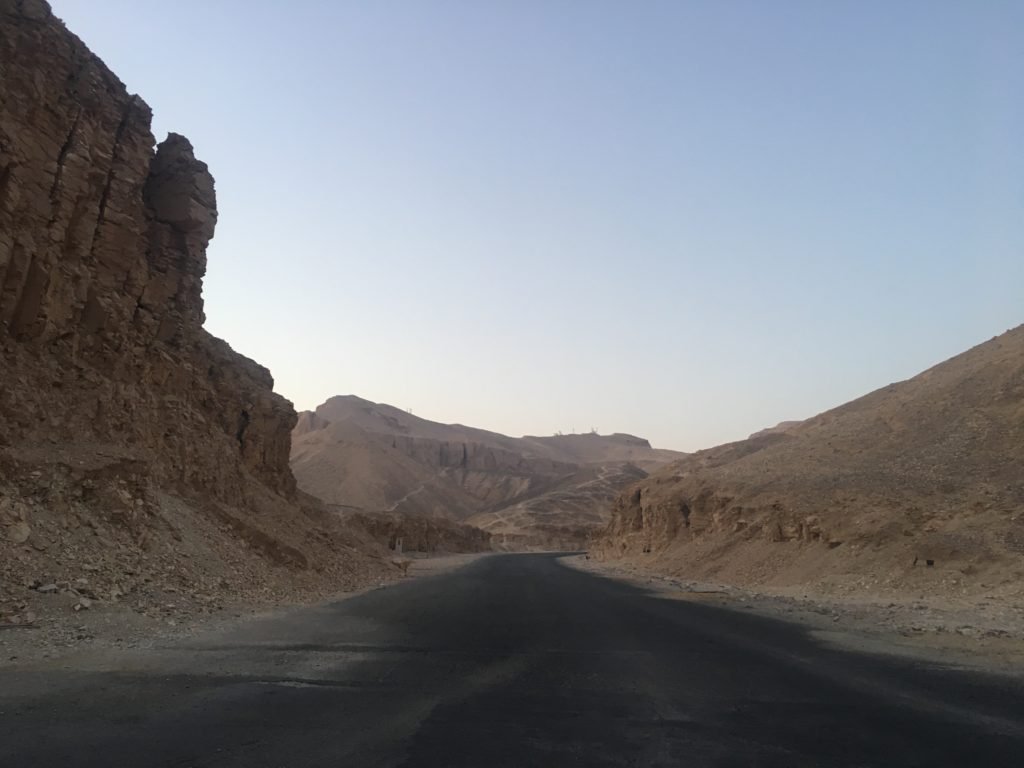
The first tomb I enter is the tomb of Ramesses IV (1155-1149 BC) who ruled only 7 years. A long narrow corridor stretches inside the mountain. The walls are covered of hieroglyphs with tales of the Book of the Dead. The ceiling is gold and blue. Falcons and vultures open wide their protecting wings above my head.
The temperature is nice. Lights and colours are soft. Not a sound except my footsteps on the wooden path. The atmosphere is serene. I reach the main chamber which hosts a massive carved sarcophagus. It is way taller than me. I raise my eyes to the ceiling, it is vivid blue. The Sky goddess Nut watches over the sarcophagus. So do all other characters painted on the surrounding walls. Men, women, gods, animals and plants of all sorts accompany the pharaoh in his after life.

There are more chambers deeper inside the mountain. But the access is restricted and barred with fences. Even being the first and only visitor does not allow you to go further. I can not remember how long I spent inside the tomb. What I do recall however is how special this moment was. I choose to head back to the surface to get the chance to visit another one before the first tourists arrive.
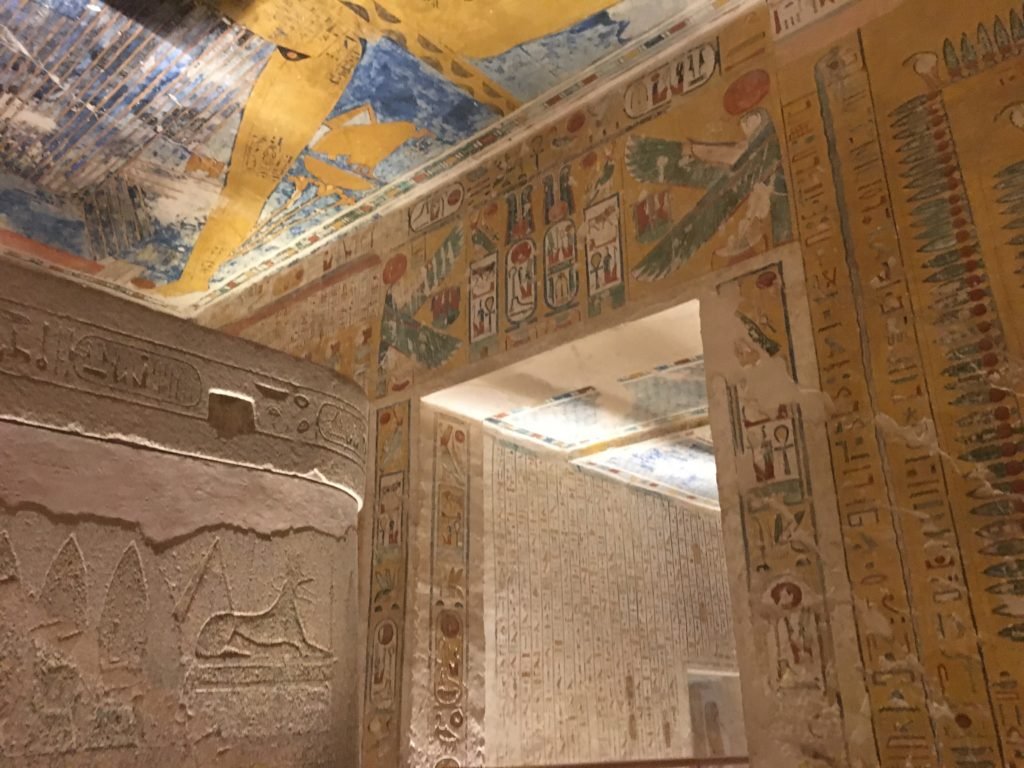
Underground splendours
Outside the sky is now blue and the mountains are not shrouded in darkness any more. First time experience inside a royal tomb of Egypt is something I shall remember for the rest of my life. There are really two separate worlds in this place named the Valley of Kings. The open air rocky desert is monochromatic and a natural landscape. Underground lay the man made wonders celebrating life, gods and pharaohs, last resting place for the kings of old times. Both worlds are quiet and look as if they would stand for thousands of years more.
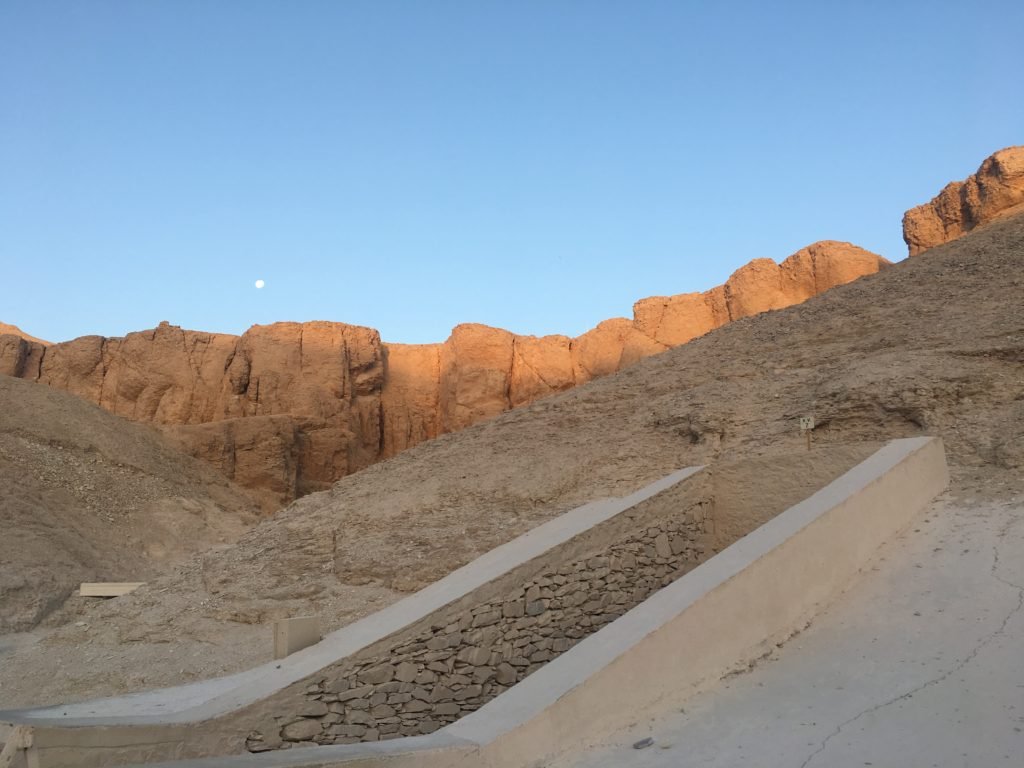
Merenptah (1213-1203 BC) is the thirteenth son of the great Ramesses II. His tomb is the next I visit. Again I am all alone inside. I check the time, it is just 7 o’clock. The burial room is much bigger than the one I have just been in. Remains of a sarcophagus stand in the centre. The tomb is badly damaged. Only fragments of frescos remain visible, yet beautiful. In its own way, the burial chamber looks almost like a modern fabrication. This is probably because it seems incredible men could build such a vast underground chamber 32 centuries ago.
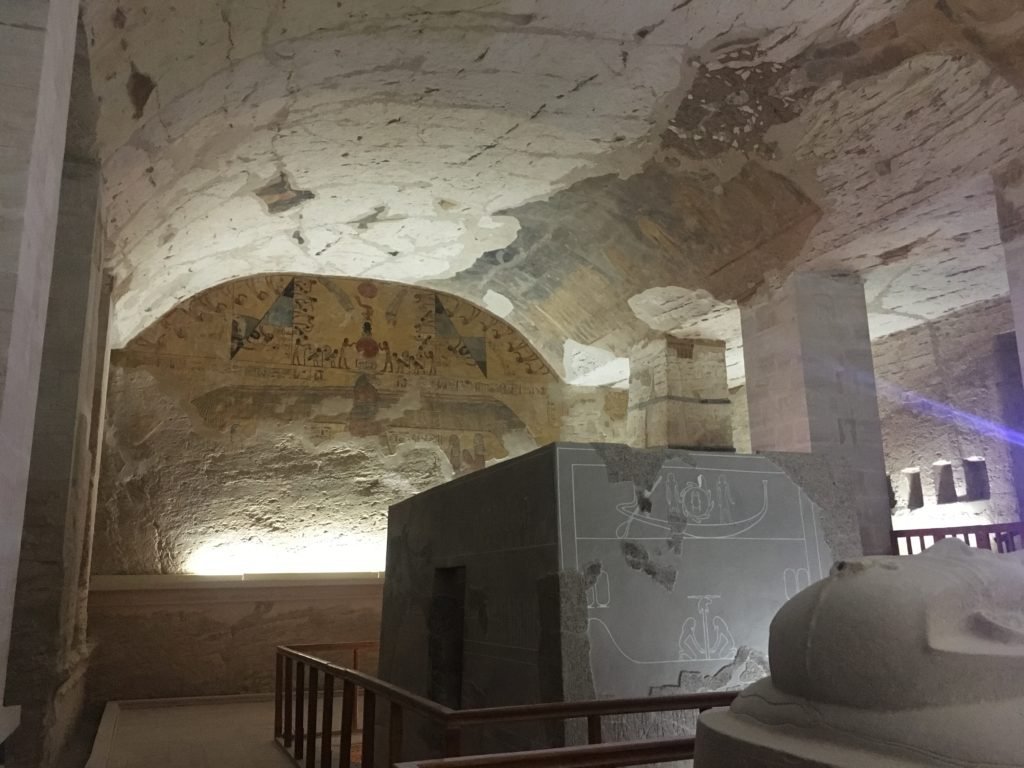
Each tomb follows a similar organization. The entrance door opens on a long corridor, which length exceeds 100 meters. A gentle slope brings the visitor down inside the mountain. Various small halls are on the way to the burial chamber at the bottom. Rich colourful hieroglyphs and carvings on the walls and ceiling are here to help the dead king find its way to the after life.
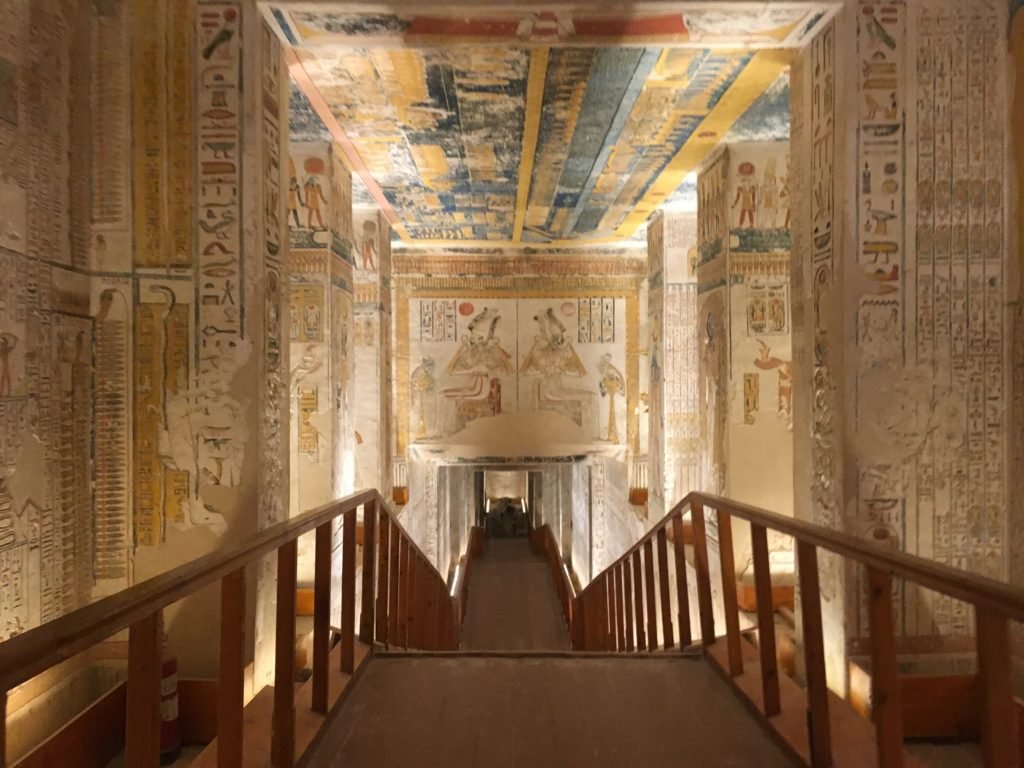
The last tomb I visit is actually for two pharaohs suceeding to each other, possibly brothers: Ramesses V (1149-1145 BC) and Ramesses VI (1145-1137 BC). In terms of beauty and state of preservation, this last tomb is also my favourite. The decoration inside is stunning and makes you want to learn how to read ancient Egyptian. The pillared hall located in the middle of the corridor is beautiful and incredibly detailed. It contains on the walls the Book of the Gates, the Book of the Day and the Book of the Night. Both pharaohs’ representations share the space equally and face each other.
The burial chamber is even more magnificent. It looks like the colours date from yesterday. Above my head, the ceiling is dark and enhances the gold of the Nut goddess. Every square centimetre of this tomb is a piece of art. A representation of Ramesses VI shows him during his afterlife, conversing with the sun god Re and Osiris.
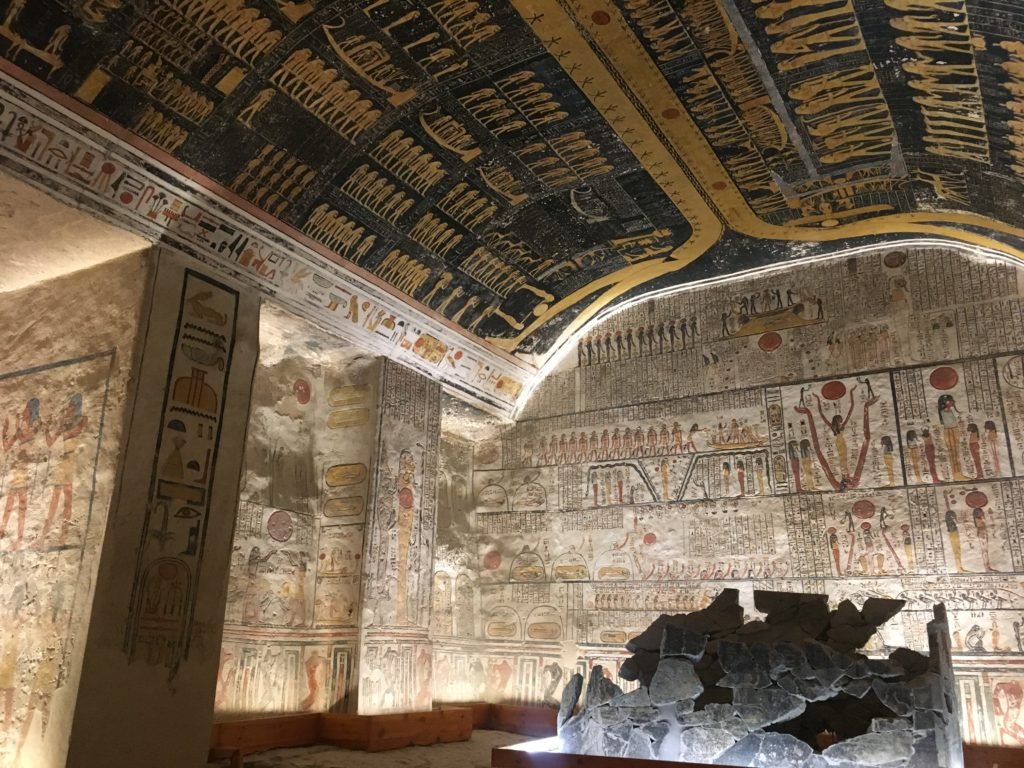
I am starting to get familiar again with the Ancient Egypt gods which I recall from my history books. There are all here on the walls. Sobek, the crocodile god of the Nile. Anubis, the dog head god of the dead. Horus, the falcon god and father of the nation. Thoth, the ibis god of knowledge and wisdom. And on and on it goes, a live lesson of history through history.
I hear voices up towards the entrance door of the tomb. The first group of tourists has arrived and starts descending the corridor. I say goodbye to the pharaohs and the Valley of Kings. In total, I spent no more than 90 minutes here but all alone. It feels I stayed for hours, as if somehow some magic came into the play. My day is actually just starting. I am heading now towards the great temple of Hatchepsut, the woman who became pharaoh.



